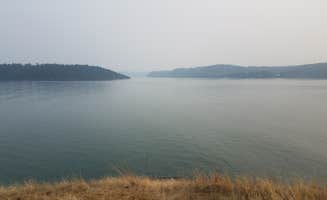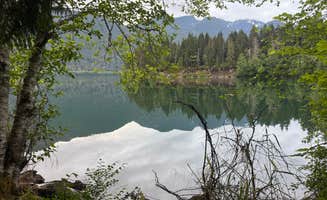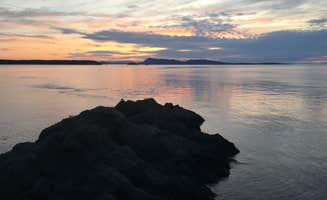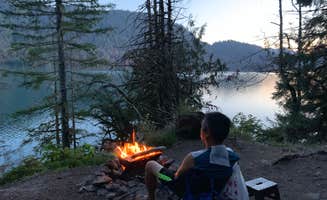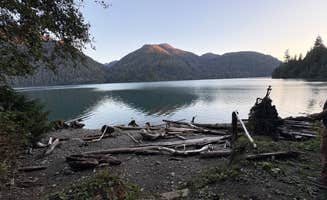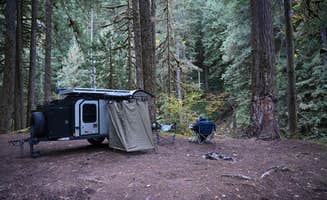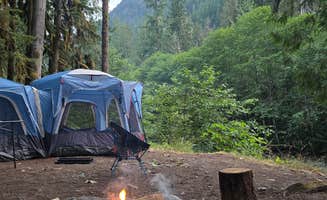Dispersed camping options near Mount Vernon, Washington extend beyond the well-known Baker Lake sites into several lesser-known forest service roads and marine access points. Mount Vernon sits at 180 feet elevation in the fertile Skagit Valley with camping areas ranging from sea level to 2,500 feet in surrounding forests. Summer temperatures typically range from 55-75°F with frequent rain possible even in summer months.
What to do
Kayak to island camping: Hope Island Marine State Park offers a unique boat-in camping experience. "We kayaked to the island, the waters were pretty rough so I would recommend for anyone planning to stay here to look into the waters, tide and wind report the day of," advises Jess G. The island features a walking trail and limited facilities.
Fish mountain streams: NF Dispersed Camping sites along forest roads provide access to clear mountain streams. "There is a fast flowing stream with crystal clear water. Quiet mountain/forest area. No sounds of civilization," notes Russel M. Multiple turnouts provide easy creek access by walking through light brush.
ORV recreation: Walker Valley ORV Recreation Area offers trail systems for off-road vehicles. Located about 15 miles east of Mount Vernon, this area features multiple established routes through forested terrain. A Northwest Forest Pass or America the Beautiful Pass is required for parking.
What campers like
Waterfront access: Lower Sandy Dispersed Camp provides lakeside camping options. "Loved this free campground on Baker Lake near mt baker, WA! Take the first turn after horseshoe cove campground and follow the gravel road all the way to the lake," recommends Jessica M. Some sites include tent pads and designated parking.
Forest privacy: Mountain Loop Hway Dispersed Camp offers secluded sites along the river. "Meandering sites along the river with good logs for benches and fire rings made from forest rocks. Heavily forested and beautiful," notes Jennifer H. The best sites appear once the paved road transitions to gravel.
Quiet atmosphere: Despite their popularity, many rustic camping areas near Mount Vernon maintain a peaceful environment. "Semi-private and peaceful. Perfect space for 2-4 people to camp. The fire pit setup was perfectly sized and shielded from wind," shares Geoffrey P. about his Lower Sandy Camp experience.
What you should know
Road conditions: Many dispersed camping roads have rough surfaces. "Probably a 4.5. Not the best site ever, but definitely good enough for a one nighter. Road was easy enough in a Subaru. Not paved and some small pot holes, but not a problem at all for us," reports Reagan S. about NF Dispersed Camping.
Site availability: Competition for prime spots increases on weekends. "All the other paid campsites were packed but found a few open spots here on the 4th of July weekend," notes Zac S. about the NF Dispersed Camping area. Weekday arrivals significantly improve your chances of securing waterfront sites.
Marine access challenges: Point Doughty presents difficulties for kayakers. "During low tide it is very rocky and tough on fiberglass kayaks, but there's a small path that can launch one or two kayaks at a time," warns Pat M. The campsite access from the beach involves a steep climb.
Tips for camping with families
Select sites with amenities: For family camping, choose areas with basic facilities. "Got a spot with lake and Mountain views. Very small, quiet, stunning campground. Felt safe. Pit toilets, fire rings, and picnic tables available," shares Haley F. about Lower Sandy Camp.
Consider accessibility: Some sites require challenging access. "The path up to the sites from the beach is very steep and slippery on the dirt but there is a rope to help. Looks like they're trying to create a stairway in the future. Not recommended if you need to haul myriad items up to the campground," cautions Pat M. about Point Doughty.
Look for swimming options: Baker Lake Road Dispersed Campsite provides good water access for families. "Many pull offs along the gravel road. Stayed at one that was overlooking the lake. Lots of spots with easy lake access," reports Eric O. These sites balance accessibility with natural amenities.
Tips from RVers
Size limitations: Most dispersed sites near Mount Vernon can't accommodate large RVs. "We have a rooftop tent, not many sites with large enough spots to park trailers or vans. Mostly tent sites that are walk in," notes Haley F. about Lower Sandy Camp.
Parking challenges: Even for smaller vehicles, parking can be difficult. "Parking for some of the spots is not the best but we were still able to car camp comfortably," explains Jessica M. about Lower Sandy. Small trailers work best at designated pullouts rather than primitive sites.
Road clearance: NF 33 Dispersed Camping requires appropriate vehicles. "The road does get much rougher the further you go, so not big-rig friendly nor for low-clearance vehicles or vehicles with bald/old tires," warns Meghan B. Most forest roads deteriorate significantly beyond the first few miles.


